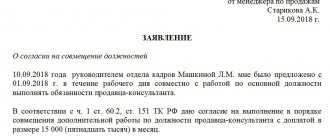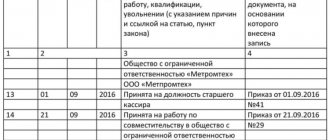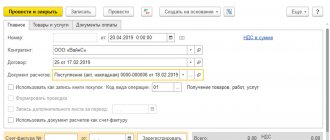Internal part-time and internal combination of positions: the difference in the formalization of relationships
An employee of the company, who is already on staff and performs a certain amount of work, decides to take on an additional load that goes beyond the scope of his current job functionality.
How can he do this? Essentially, in this case, independent labor relations between the company and the specialist come into force, which can be formalized in 2 forms:
- internal part-time job;
- combination of positions (professions).
There is a fundamental difference between the two forms that the company must understand. Namely: internal part-time work means performing work unrelated to the main one, at a time that is not occupied by the specialist’s main activity (Article 60.1, 282 of the Labor Code of the Russian Federation). In other words, the second job (internal part-time) is performed completely outside the scope of the employee’s main position.
If you have access to ConsultantPlus, find out the intricacies of registering a combination of positions, which will allow you to avoid disputes with inspectors. If you don't have access, get a free trial of online legal access.
An example of an external combination:
G.V. Ivanov works as a mechanic at a manufacturing enterprise. The working day of a mechanic in production is from 9:00 to 18:00. At the same time, he decides to get a part-time job as a cleaner at the same company. He performs the labor functions of a cleaner after his working day as a mechanic ends, i.e. from 18:00 to 21:00. In this case, he does not combine positions, but performs the functions of a cleaner as his additional work on an internal part-time basis in that the same company.
Internal combination of positions assumes that a specialist continues to work within the framework of his main job duties and, in addition, during the generally established working day manages to perform other functions corresponding to another position. That is, a specialist is engaged in work to combine another position in parallel with his main work, at the same time (Article 60.2, 151 of the Labor Code of the Russian Federation).
An example of combining professions:
G.V. Ivanov from the previous example works as a mechanic, but in addition, during the working day (from 9:00 to 18:00) he also has time to clean the workshop. Such relationships can be formalized as a combination of the professions of a mechanic and a cleaner within one production enterprise.
The above features also determine differences in the design of labor relations. Namely: for an internal part-time worker it is necessary to draw up a separate employment contract. When combining positions, the previous employment contract is sufficient, but an additional agreement must be issued to it.
Work on combining positions: registration
If an employee wants and can work in 2 positions in the company at the same time, then the preferable option for him is to formalize additional relations with the employer in the form of combining positions. But for this it is important that the specifics of the work allow it to be performed without release from the main activity and at the main workplace. Therefore, if the second position requires, for example, moving from the main place of work (to another workshop), then such an additional load on the employee should be formalized as an internal part-time job, and not as work combining positions.
The company can formalize the combination of positions by an additional agreement to the employee’s current employment contract, which, in particular, will specify what position he intends to combine, as well as the period during which the combination of positions will take place (Article 72 of the Labor Code of the Russian Federation).
In addition, for work combining positions, the employee must, by virtue of Art. 60.2 of the Labor Code of the Russian Federation, receive an additional payment, the amount (or calculation method) of which should also be fixed in an additional agreement to the employment contract.
The grounds for drawing up such an agreement when combining positions are the following documents (depending on who initiated the combination):
- the company’s proposal to combine positions signed by the employee;
- application from an employee requesting permission to combine positions.
At the same time, it is important for the company to remember that in the work book of a specialist who combines several positions, there is no need to reflect the fact of combination, since such an obligation is not provided for by law.
In addition, companies often have a question: should the time spent by a specialist on a combined position be recorded in a time sheet? In accordance with the norms of labor legislation, combination work is not separately highlighted in the timesheet. After all, the employee performs combined work in parallel, at the same time in which he is busy with his main work. Therefore, only the hours spent on the main work need to be recorded on the timesheet.
How to write a consent
An employer can offer an employee to combine his or her duties with a second job either in writing (in the form of a letter, notice, memo) or orally. The answer must be provided in writing only. There is no unified form; the order of text formatting is as follows:
- Addressed to the head of the enterprise, indicating the position, department, full name. employee.
- Document's name.
- The text contains a link to the articles of the Labor Code of the Russian Federation, the vacant position, the period, and the amount of additional payment.
- It is clarified that the employee is notified of the right to refuse early by giving 3 working days written notice. This is not required, but it is useful for the employee to know.
- The date of writing, signature and transcript of the signature are indicated.
This document serves as the basis for concluding an additional agreement to the employment contract and issuing an order.
Documents are drawn up in a similar way to fulfill the duties of an absent employee, increase the scope of work, and expand the service area.
Sample
Here is an example of a sample of an employee’s consent to perform additional work, drawn up in accordance with all the rules:
Order on internal combination - sample
After signing the additional agreement, the company should issue a corresponding order.
Russian labor legislation does not contain a specific unified form for such an order.
At the same time, it should indicate which positions the employee will combine, for what period and for what additional payment. In this case, as a basis for combination, the order must specify the details of the additional agreement drawn up with the employee.
The order form for combining positions can be downloaded for free by clicking on the picture below.
A sample order can be viewed on our website:
Main components of an order
There is no special unified form for this kind of documents, since each organization has its own specifics. It must be taken into account in the content. However, there are data without mentioning which the order does not have proper legal force or can be challenged in court. These include:
- Full name of the organization. It should always be located at the top, in the middle of the sheet.
- Order number. It is then entered into the journal of orders on personnel matters.
- Date of acceptance (signing) of the document.
- The city in which the document is signed.
- Leader motivation. The formal style describes what prompted management to resort to combining several positions with one employee. It is advisable to draw up a separate order for each such person holding multiple positions.
- Link to Article 151 of the Labor Code. It talks about this right of the employer.
All this information relates to the basics, but is not directly related to what exactly is being accepted. The whole point is contained in several paragraphs of the order on combining positions. They must inform the reader about:
- Full name of the employee who assumes additional functions.
- The date the employee began combining positions.
- If available, end date. It may not be a date, but an event in connection with which such a combination is completed. For example, “until the appointment of a new secretary” or “until A.A. Ivanova returns from maternity leave.”
- Amount of additional payment for combination. Usually it is 40-50% of the salary.
- The one who is obliged to inform the employee that he combines someone else’s responsibilities.
As an additional link, information about the amendment to the employment contract can be located. Without such an addition, the employee cannot begin combining responsibilities.
At the very end of the order is the signature of the manager and the employee who accepts the fact of combining his position with someone else’s. Also, if there is a mention of the chief accountant, personnel officer or other specialists (if they are obliged to comply, take into account, inform, etc.), their signatures are also required.
Completion of combining positions
As mentioned above, if a company organizes a combination of positions, then the period during which such combination will be valid is determined in advance. Therefore, the question arises: what will happen after this period?
The combination ceases to be valid, i.e. the employee is further obliged to perform only his main duties. At the same time, the legislator does not provide for the need to draw up any special document closing the combination.
Therefore, everything here remains at the discretion of the company: you can issue a special order that terminates the employee’s combined powers, or you don’t have to do this - the combination will still be considered completed (unless the company has issued another order extending the employee’s combined powers). You can download a sample of such an order for free from the link below:
In addition, the Labor Code of the Russian Federation establishes that at any time, both one and the other party can stop combining unilaterally (Article 60.2 of the Labor Code of the Russian Federation). To do this, you simply need to send the appropriate notice (if the initiator of the cancellation is a company) or a statement (if the initiator is an employee) to the other party no later than 3 business days in advance.
Make an entry about the dismissal of an internal part-time worker in the work book only if he has approached you with such a request. The entry must correspond to the text of the dismissal order. Additionally, indicate in the work book that the employee is resigning from a part-time job. This will avoid confusion as to which job - at the main place or part-time - the dismissal record refers to.
ATTENTION! If the initiator of the termination of the combination is the company, then it makes sense for it to acquaint the employee with the relevant notice against a receipt, so that later it does not turn out that he, since he knew nothing about the cancellation, continued to work for some time, combining 2 positions, for which he demands appropriate remuneration.
Sample consent for combining positions
If you need to draw up an agreement to combine two positions, which you have never written before, read the explanations for the document given here and look at the example - using it, you can easily write your own document.
- At the beginning of the consent, indicate to whom you are addressing it: the name of the company, position and full name of the director (or the employee performing his duties).
- Next, enter your own data in the same way.
- After this, in the middle of the line write the word “Statement”, below - “on consent to combine two positions.”
- Next, formulate the main part. First of all, indicate when and by whom the combination was offered to you, then that you agree with this working regime.
- Be sure to indicate in your application the amount of remuneration agreed with management for the additional amount of work, as well as a link to the article of the Labor Code of the Russian Federation in accordance with which you are acting.
- At the end, do not forget to sign your consent.
Internal part-time work according to the Labor Code of the Russian Federation
An internal part-time worker, unlike a specialist who combines positions, by virtue of the Labor Code of the Russian Federation, works in the main company in a second, additional job, but at a time that is not occupied by the main activity (Article 282, 60.1 of the Labor Code of the Russian Federation).
The Labor Code of the Russian Federation establishes a number of restrictions regarding how much working time an employee can spend on part-time work. So, if a specialist within the same organization works in two different positions at different times, then the Labor Code of the Russian Federation allows the maximum additional workload to be performed no more than 4 hours a day.
IMPORTANT! If there is a day when an employee is released from his main job for some reason, he can do part-time work throughout the working day.
For a month in the aggregate, a part-time employee has the right to work no more than half of the monthly standard of time established for the category of workers to which he belongs (Article 284 of the Labor Code of the Russian Federation). However, sometimes an employee has the right not to be guided by the specified limit.
For more information about how much time an employee has the right to spend on part-time work, see the article “Part-time work - how many hours per week?” .
An equally important question for both internal part-time workers and their employers is: how to pay for such work? Art. 285 of the Labor Code of the Russian Federation says that payment must be established in one of 3 ways:
- in proportion to the time spent working;
- according to a piecework scheme;
- on other conditions provided for in the employment contract.
For information on the specifics of additional payment up to the minimum wage for internal part-time workers, see the article . ”
In addition to the above, companies should keep in mind that if they have someone on their staff who works part-time in addition to their main job, then they are also entitled to leave of at least 28 days (Articles 114, 115 of the Labor Code of the Russian Federation). It is combined with vacation in the main position in time, however, vacation pay is accrued separately for the main position and separately for the combined work, since the employee has 2 independent employment contracts with the company (Articles 286, 287 of the Labor Code of the Russian Federation).
An important issue that concerns, in particular, part-time women, concerns the provision of maternity benefits to them.
Read more about this in the article “Maternity benefits for part-time workers .
How to apply for an internal part-time job
As stated above, when working on a part-time basis, a separate employment contract is drawn up. At the same time, he is subject to all the requirements that apply to similar contracts with regular full-time employees (not part-time employees).
ATTENTION! An internal part-time worker must have exactly two : for the main job and for a part-time job.
In particular, the employment contract must contain information about:
- companies;
- a position that a specialist undertakes to perform in addition to his main job;
- wage system;
- work and rest regime, etc. (Article 57 of the Labor Code of the Russian Federation).
As a general rule, such an agreement must be drawn up in writing, in 2 copies (one for the company and one for the employee).
ATTENTION! The employment contract must include information that the employee holds the position on an internal part-time basis.
Find out how to register an internal part-time job in your work book in ConsultantPlus. Get trial demo access to the K+ system and switch to the Standard Situation for free.
Order and application for internal part-time work
According to the norms of the Labor Code of the Russian Federation, in order for an employment contract with an internal part-time worker to be considered concluded, such a specialist, among other documents, must submit to the company an application for employment on an internal part-time basis, in which, in particular, it should be indicated what additional work he intends to take on the employee, as well as at what hours he will perform it.
The prepared application must be submitted in writing to the company's human resources department.
As a general rule, after an employment contract is concluded, the company must issue an order confirming the hiring of a specialist (Article 68 of the Labor Code of the Russian Federation). The same is true for internal part-time workers. This means that there will be two : for the main position and part-time.
At the same time, there is a unified form of such an order (No. T-1), which you can download for free on our website.
In such an order, it is important to reflect the very fact of internal part-time work, and in addition, indicate the basic conditions of the specialist’s work, its nature and the mechanism of remuneration.
On what grounds can a combination be carried out?
Combining several professions or positions
This concept presupposes that an employee performs several types of duties, each of which relates to a specific position. In this case, two main conditions must be met:
- both types of work must be carried out by an employee under the same manager - that is, in the same organization or company;
- all types of duties are performed during one working time, that is, one shift or day.
The concept of “profession”, as a rule, applies to employees working in blue-collar occupations, while the concept of “position” is used in relation to administrative specialists, civil servants, etc.
An example of combining positions could be the chief accountant performing the duties of a legal adviser.
Expanding the service area or increasing the volume of work performed
These concepts imply an increase in the amount of work without taking on the responsibilities associated with another profession. In fact, the employee simply takes on the responsibility to perform a larger volume of work that is part of his immediate job responsibilities. For example, a maintenance engineer for one site in a manufacturing facility agrees to take on additional maintenance responsibilities for a new site. Thus, the volume of his regular work increases.
Taking on additional responsibilities for a temporarily absent employee
If an employee is absent for a sufficiently long period of time, another employee may temporarily assume the duties of the employee's job. In this case, the absence of an employee can be caused either by his illness or by being on a business trip or on scheduled leave.
For example, an assistant accountant often takes on the functions of the chief accountant for the period while the latter is on annual paid leave. At the same time, the current regulations do not place absolutely any restrictions regarding positions that may involve part-time work.
The only nuance here will be the mandatory consent of the employee himself to accept additional work responsibilities. This consent must be in writing.
In addition, the employee always has the right to refuse additional duties. If he no longer wishes to perform previously completed work tasks, he can at any time write a corresponding application and submit it to the employer.
Results
Registration of imposing additional workload on a company employee can be expressed in 2 forms: internal part-time work and combination of positions. If an employee intends to perform labor functions in a position that requires distraction from his main job, then such labor relations must be formalized in the form of a separate employment contract on internal part-time work. At the same time, it is important for the company not to forget to receive a corresponding application from the employee, as well as issue an order to hire an internal part-time worker. If the additional position does not involve distraction from the main job, then the specialist can combine them, that is, work at the same time in several positions in the company. Registration of internal combination of positions is carried out by signing an additional agreement to an existing employment contract. The company should also receive a corresponding signed application from the employee and formulate an order to organize the combination of positions.
Sources:
Labor Code of the Russian Federation
You can find more complete information on the topic in ConsultantPlus. Free trial access to the system for 2 days.
Consent form
There are two ways to confirm that the employee agrees to combine positions: either we will receive written consent from him to combine positions in one organization, or the employee will write an application asking for permission to combine positions. These are equal documents. The employee writes a statement when the initiative comes from him, we take consent when the initiator is the employer.
In practice, there is a third option - on the finished order, the employee writes “I have read and agree.” The sequence is broken: if the order has already been signed, it is a valid regulatory act that cannot be issued before the employee agrees. In addition, the signing of the order must be preceded by the signing of an agreement to the employment contract on the performance of additional work. Therefore, first there is a statement, then an agreement and only then an order.
ConsultantPlus experts analyzed in what cases overtime work is registered, and when - part-time work and combination work. Use these instructions for free.







